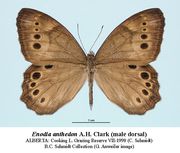Species Details
Enodia anthedon
University of Alberta E.H. Strickland Entomological Museum Read more about this collection »
Common NameNorthern Pearly-eye
SeasonalityAdults fly from June to mid July.
IdentificationThis medium sized butterfly has a wingspan of 45-67 mm and black antennal clubs. Dorsal wing surface is purplish brown and there are dark eyespots on both the fore and hindwings. Ventral wing is also purplish brown. The ventral forewing has a row of four black spots that are aligned with each other, the spots are surrounded by diffuse white and have white pupils. It can be distinguished from other satyrids in Alberta by its purplish brown colour, the presence of large eyespots, and the angled hindwing margin.
The short, barrel-shaped eggs are green (Bird et al., 1995).
Larvae have green yellow heads with red-tipped horns. Their bodies are yellowish green with green and yellow stripes. They also have a cleft tail tipped with pink (Bird et al., 1995).
Pupae are green with cream-coloured heads (Bird et al., 1995).
Scientific Name
Enodia anthedon
Common Name
Northern Pearly-eye
Habitat
A shade-loving butterfly found in poplar woods near streams and lakes in East Central Alberta.
Seasonality
Adults fly from June to mid July.
Identification
This medium sized butterfly has a wingspan of 45-67 mm and black antennal clubs. Dorsal wing surface is purplish brown and there are dark eyespots on both the fore and hindwings. Ventral wing is also purplish brown.…
This medium sized butterfly has a wingspan of 45-67 mm and black antennal clubs. Dorsal wing surface is purplish brown and there are dark eyespots on both the fore and hindwings. Ventral wing is also purplish brown. The ventral forewing has a row of four black spots that are aligned with each other, the spots are surrounded by diffuse white and have white pupils. It can be distinguished from other satyrids in Alberta by its purplish brown colour, the presence of large eyespots, and the angled hindwing margin.
The short, barrel-shaped eggs are green (Bird et al., 1995).
Larvae have green yellow heads with red-tipped horns. Their bodies are yellowish green with green and yellow stripes. They also have a cleft tail tipped with pink (Bird et al., 1995).
Pupae are green with cream-coloured heads (Bird et al., 1995).
Life History
The Northern Pearly-eye is univoltine and overwinter as larvae (Bird et al., 1995). Males perch on tree trunks or vegetation up to 10 feet above ground at edges of clearings to wait for females (Opler et al., 1995). …
The Northern Pearly-eye is univoltine and overwinter as larvae (Bird et al., 1995). Males perch on tree trunks or vegetation up to 10 feet above ground at edges of clearings to wait for females (Opler et al., 1995). Females lay eggs singly on the host plant (Opler et al., 1995).
Conservation
Extremely rare in Alberta; provincial rank S1 and "Status Undetermined" because of few records.
Diet Info
Unknown for Alberta. In the United States, larval host plants include: white grass (Leersia virginica), bearded shorthusk (Brachyelytrum erectum), False Melic Grass (Schizachne pupurascens), plumegrass (Erianthus),…
Unknown for Alberta. In the United States, larval host plants include: white grass (Leersia virginica), bearded shorthusk (Brachyelytrum erectum), False Melic Grass (Schizachne pupurascens), plumegrass (Erianthus), broadleaf uniola (Uniola latifolia), and bottlebrush (Hystrix patula) (Acorn 1993; Opler et al. 1995; Layberry et al. 1998; enature 2000). Adults feed on dung, fungi, carrion, mud, and sap from willows, poplars, and birch (Opler et al. 1995).
Range
Recent records from central Alberta suggest that E. anthedon may be extending its range (Alberta Natural Heritage Information Centre, 2002). Its Canadian range extends east from Central Alberta to Nova Scotia…
Recent records from central Alberta suggest that E. anthedon may be extending its range (Alberta Natural Heritage Information Centre, 2002). Its Canadian range extends east from Central Alberta to Nova Scotia (Layberry et al., 1998; Opler et al., 1995). In the United States, it is found south from the Canadian border to central Alabama and Mississippi and from Nebraska eastward (Opler et al., 1995).
References
Author
Bird, C. D., G.J. Hilchie, N.G. Kondla, E.M. Pike and F. A. H. Sperling
Title
Alberta Butterflies
Publication Date
1995
Pages
349
Title
Alberta Natural Heritage Information Centre
Author
Acorn, John
Title
Butterflies of Alberta
Publication Date
1993
Pages
143
Title
Butterflies of North America
Title
eNature.com
Title
NatureServe Explorer
Author
Layberry, Ross A.; Hall, Peter W. and J. Donald LaFontaine
Title
The Butterflies of Canada
Publication Date
1998
Pages
280
Author
Alberta Sustainable Resource Development.
Title
The General Status of Alberta Wild Species 2000.
Publication Date
2001
Pages
46
Specimen Information
There are 4 specimens of this Species.
UASM59045 - Enodia anthedon
University of Alberta E.H. Strickland Entomological Museum
Place CollectedCanada: Alberta, Fort McMurray
Collected ByMacaulay, D.
Date Collected2005-07-02
UASM59256 - Enodia anthedon
University of Alberta E.H. Strickland Entomological Museum
Place CollectedCanada: Alberta, Edmonton
Collected ByAnweiler, G. G.
Date Collected2006-07-05
UASM211030 - Enodia anthedon
University of Alberta E.H. Strickland Entomological Museum
Place CollectedCanada: Alberta, Opal Natural Area
Collected ByNazari, V.
Date Collected2003-07-08
BIRD38080 - Enodia anthedon
University of Alberta E.H. Strickland Entomological Museum
Place CollectedCanada: Alberta, Winfield
Collected ByBird, C. D.
Date Collected2016-07-01



